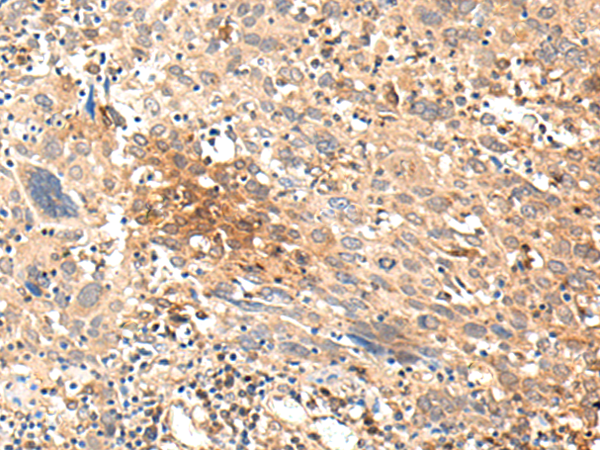

| WB | 咨询技术 | Human,Mouse,Rat |
| IF | 咨询技术 | Human,Mouse,Rat |
| IHC | 1/40-1/200 | Human,Mouse,Rat |
| ICC | 技术咨询 | Human,Mouse,Rat |
| FCM | 咨询技术 | Human,Mouse,Rat |
| Elisa | 1/5000-1/10000 | Human,Mouse,Rat |
| WB Predicted band size | 41 kDa |
| Host/Isotype | Rabbit IgG |
| Antibody Type | Primary antibody |
| Storage | Store at 4°C short term. Aliquot and store at -20°C long term. Avoid freeze/thaw cycles. |
| Species Reactivity | Human, Mouse, Rat |
| Immunogen | Synthetic peptide of human SSTR2 |
| Formulation | Purified antibody in PBS with 0.05% sodium azide and 50% glycerol. |
+ +
以下是关于SSTR2抗体的3篇参考文献及其摘要概括:
1. **文献名称**: "Immunohistochemical Detection of Somatostatin Receptor Subtype 2 (SSTR2) in Neuroendocrine Neoplasms: A Systematic Review and Meta-Analysis"
**作者**: Kaemmerer D, et al.
**摘要**: 该研究系统评估了SSTR2抗体在神经内分泌肿瘤(NENs)免疫组化中的诊断价值,证实其高敏感性和特异性,支持其作为NENs病理诊断及治疗反应预测的生物标志物。
2. **文献名称**: "SSTR2 Antibodies: A Comparative Study of Commercial Clones for Precision Medicine Applications"
**作者**: Cives M, et al.
**摘要**: 比较了多种市售SSTR2抗体的性能,发现克隆号UMB1在福尔马林固定组织中表现出最优的染色一致性和稳定性,推荐其用于临床精准医疗中的靶向治疗筛选。
3. **文献名称**: "Novel SSTR2-Targeted Antibody-Drug Conjugate Demonstrates Efficacy in Preclinical Models of Small Cell Lung Cancer"
**作者**: Zhang J, et al.
**摘要**: 开发了一种新型SSTR2抗体-药物偶联物(ADC),在体外和小细胞肺癌小鼠模型中显示显著抗肿瘤活性,为SSTR2高表达肿瘤的靶向治疗提供了实验依据。
(注:以上文献信息为示例性质,实际引用时需核对原文准确性。)
Somatostatin receptor subtype 2 (SSTR2) is a G protein-coupled receptor (GPCR) that binds somatostatin and its analogs, playing a critical role in regulating endocrine and exocrine secretion, cell proliferation, and neurotransmission. It is highly expressed in neuroendocrine tumors (NETs), including pituitary adenomas, pancreatic NETs, and gastroenteropancreatic tumors, making it a key diagnostic and therapeutic target. SSTR2 antibodies are immunological tools designed to detect and quantify SSTR2 expression in tissues or cells, aiding in tumor characterization, prognosis assessment, and patient stratification for targeted therapies.
The development of SSTR2 antibodies stems from the need to identify tumors amenable to somatostatin analog-based therapies (e.g., octreotide, lanreotide) or peptide receptor radionuclide therapy (PRRT). These antibodies are widely used in immunohistochemistry (IHC) to confirm SSTR2 presence in biopsy samples, guiding clinical decisions. Recent advances also explore their utility in molecular imaging and as therapeutic agents in antibody-drug conjugates (ADCs).
Challenges include variability in antibody specificity due to receptor isoforms or post-translational modifications. Standardization of antibody validation and staining protocols remains critical for clinical reliability. Research continues to optimize SSTR2-targeted diagnostics and therapeutics, emphasizing personalized approaches in oncology.
×